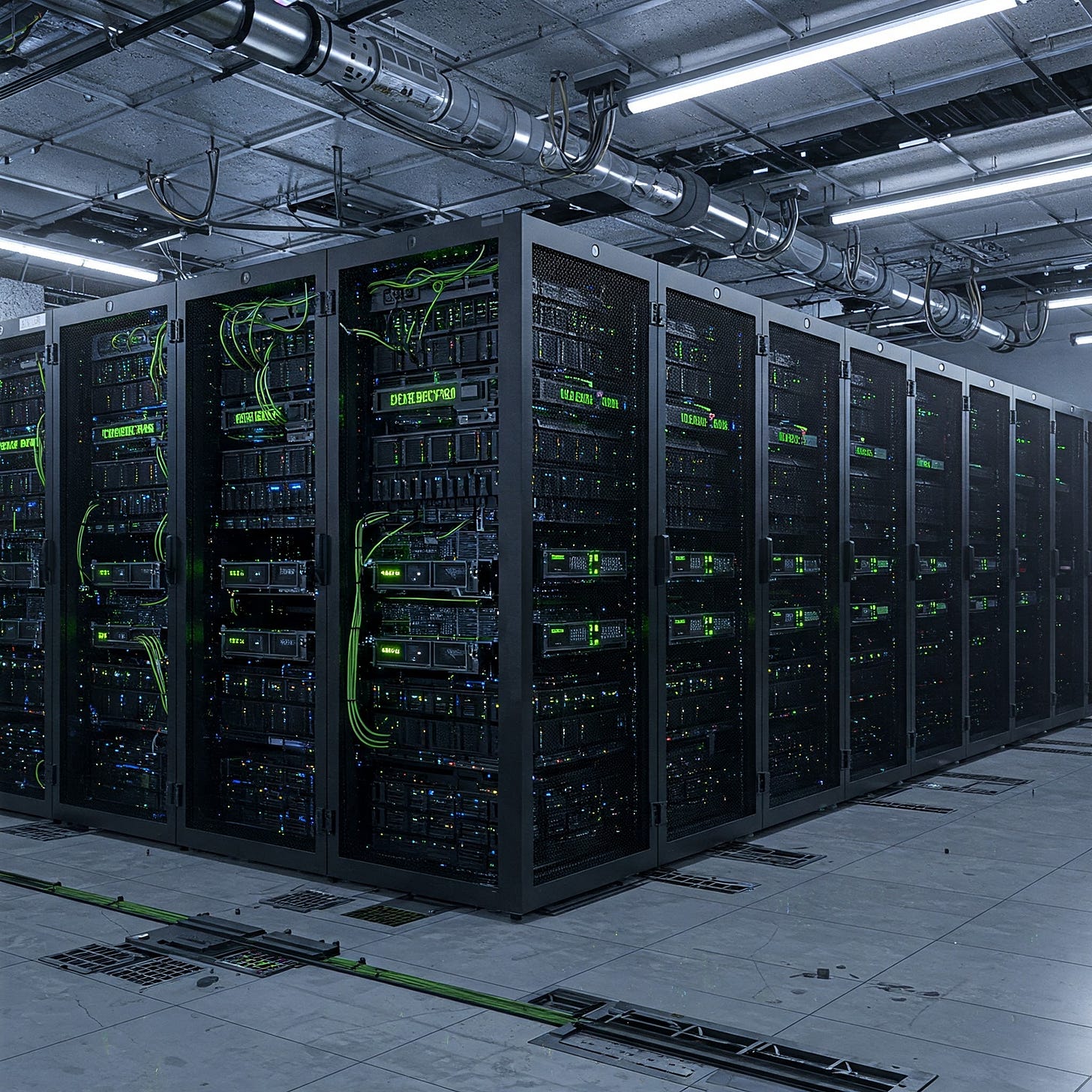DeepSeek AI Cost-Efficiency Breakthrough vs. Jevons Paradox: Will HPC & NVIDIA GPU Demand Increase?
Many claim that cost-efficiency improvements in AI models will result in "Jevons Paradox" (increased demand for HPC and/or GPUs)... this isn't guaranteed.
The hyper-polarized reactions to “DeepSeek AI” across X/Twitter have been somewhat nuts. It’s true that DeepSeek’s team unleashed novel architectural innovation to enhance the cost-efficiency of cutting-edge AI.
It is also likely true that DeepSeek developed their R1 model specifically with ~$6M. Very good. However, the framing of this achievement was misleading by the media and many smart people.
The mainstream media legitimately did not know there were high lead-up costs of ~$1.3B before arriving at R1. Smart people with animosity toward OpenAI (for being closed source) and/or NVIDIA (missed out on investment or want it to crumble) — intentionally gloss over or fail to acknowledge lead-up costs.
If you listed to mainstream media and/or those with an agenda to undermine U.S. AI and/or NVIDIA — you’d think DeepSeek was created by a fleet of blindly-selected rice farmers on the annual budget of a Beijing homeless shelter with a standalone jerry-rigged Huawei HiSilicon GPU made in 2020.
These zealots were quickly confronted with extreme backlash from another cohort of zealots: “China bad” and/or NVIDIA bulls (i.e. >50% of net worth tied up in NVDA). The reaction? Something like: Haha you’re so dumb, you must not know about… Jevons Paradox. (Do you even Jevons paradox bro?)
The reality is that Jevons Paradox might happen… which could help NVIDIA… but it could also hurt NVIDIA if the increased HPC demand is filled by other vendors (e.g. Huawei, AMD, etc.). But, there’s no guarantee that Jevons paradox does happen.
I’d lean towards it being more likely that Jevons paradox happens based on my interpretation of things and what various smart people are suggesting, but no guarantees. Don’t assume it will. Hindsight will be 20/20.
RELATED: Debunking DeepSeek AI: China’s ChatGPT vs. OpenAI & NVIDIA
DeepSeek AI: Jevons Paradox vs. NVIDIA GPUs & HPC Demand (Overview)
A.) Start of the Debate
DeepSeek’s latest AI model, “R1,” ignited a fierce debate across the AI community and tech investment circles.
Prominent in that debate are the so-called “NVIDIA bulls,” who argue that cost savings from new AI breakthroughs will actually increase overall GPU demand—thanks to something called Jevons’ Paradox.
Meanwhile, “NVIDIA bears” counter that if it truly costs only a fraction of the usual budget to achieve near–o1/GPT4-level performance, the enormous HPC expansions that have propelled NVIDIA’s growth might soon taper off.
B.) The $6 M Training Cost Controversy
DeepSeek’s claim is that it trained a ChatGPT‑like reasoning model for around $6 M in its final training run.
Some interpret this as a potential “GPU-killer”—since labs could presumably do more with fewer GPUs.
Others note that the $6M figure excludes substantial prior R&D, hardware ownership, and experimental runs.
Despite the nuances, the figure itself is fueling speculation on whether AI labs will keep spending billions on advanced GPU clusters or switch to more cost‑efficient methods.
C.) Nadella, Gelsinger, Jevons’ Paradox
Two high-profile industry leaders, Satya Nadella (Microsoft CEO) and Pat Gelsinger (former Intel CEO), have both referenced a version of Jevons’ Paradox to explain why AI efficiency might raise AI use and potentially hardware compute demand.
Nadella has said that cheaper AI “will see usage skyrocket.” This implies AI use will increase. It doesn’t automatically imply HPC/GPU demand will increase, but might. (LINK)
Pat Gelsinger stated that “Computing obeys the gas law. Making it dramatically cheaper will expand the market for it.” Gelsinger believes that when the cost of AI drops (such as with DeepSeek’s architecture), HPC demand will increase (even if it seems paradoxical).
Nonetheless, critics remain unconvinced, pointing to data constraints, custom chips, or regulatory pressures that could limit HPC expansions.
RELATED: 2025 AI Chip Game Theory: U.S. Export Controls vs. China & NVIDIA GPUs
DeepSeek’s Breakthroughs & Implications
R1 Model: Cost & Performance
DeepSeek’s “R1” model garnered buzz by matching (or nearly matching) OpenAI’s o1/ChatGPT-level performance in math, coding, and reasoning tasks—despite training with significantly lower final-run expenses (~$6M).
This cost figure only covers the last stage of training; still, it’s striking. R1’s success rests on four main pillars:
FP8 Mixed‑Precision: Instead of standard FP16 or BF16, DeepSeek uses a custom 8‑bit floating‑point configuration for most forward passes and partial training steps, drastically cutting memory usage.
Mixture-of-Experts (MoE): Activating only a subset of specialized “experts” per token or query, reducing the full parameter load.
Chain‑of‑Thought + Reinforcement Learning: Reinforcement learning encourages multi‑step reasoning; “R1‑Zero” even does so with minimal supervised fine‑tuning.
Context Caching: Disk caching repeated conversation prefixes, reducing token reprocessing up to 90%.
Why These Methods Might (or Might Not) Become Mainstream for AI Scaling
Potential Impact: If these DeepSeek AI model architectures and scaling methods become mainstream, AI labs may be able to slash GPU count needed for state-of-the-art reasoning models, thus reducing capital expenditures on HPC clusters.
Implementation Challenges:
FP8 requires specialized kernels and robust scaling to avoid numerical instability.
MoE gating overhead can complicate HPC scheduling.
Reinforcement-based chain-of-thought still has uncharted domains of reliability.
Partial Adoption: Labs might adopt some (e.g., FP8) but not the entire suite. Even partial implementation of DeepSeek’s approach can meaningfully lower training costs—raising the question: Would HPC expansions slow if you can achieve the same end performance for less money? Not necessarily.
Takeaway: DeepSeek’s “R1” stands as a high-profile case study in advanced, cost‑efficient AI methods—impressive, but not necessarily an across-the-board HPC killer. To understand how these cost savings might reshape the broader AI ecosystem, we need to consider Jevons’ Paradox and how efficiency can end up increasing total usage.
Jevons’ Paradox in AI: Basics & Relevance
A.) Jevons’ Historical Roots
Coined by economist William Stanley Jevons in 1865: improving coal‑burning efficiency led to higher total coal consumption.
Similar patterns in lighting (transition from incandescent to LED), data storage (exponential expansion once cost per GB fell), etc.
B.) Paradoxical Twist
Intuition says: “If it takes fewer GPUs to train a big AI model, HPC budgets shrink.”
Jevons suggests the reverse can happen: “If each run is cheaper, you might just do many more runs or bigger runs, thus raising total GPU usage.”
C.) Why AI Might or Might Not Obey Jevons
Yes (Pro-Jevons)
Pat Gelsinger: “Computing obeys the gas law. Making it dramatically cheaper will expand the market for it. The markets are getting it wrong.” (LINK)
Labs can reallocate ‘saved’ cost from baseline training to advanced inference or extra training cycles. (Read: Top 8 Stocks for DeepSeek AI-Style Scaling: High-Load Inference)
No (Counter-Argument)
Data/regulatory bottlenecks, or stagnating ROI, might cap expansions.
Custom chips or new architectures could make each HPC cycle so cheap that total spending does not grow as quickly.
D.) Jevons for AI vs. HPC vs. NVIDIA
AI: Each lab or new entrant might exploit cheaper resource usage, so the total number of major training/inference runs can increase.
HPC (General Demand): HPC expansions typically feed off “killer apps.” AI is one such “killer app.” If AI booms, HPC investments likely increase—unless external constraints intervene.
NVIDIA: If HPC usage climbs, GPU demand grows. But if MoE or partial solutions drastically reduce per-unit GPU needs, or if labs adopt alternative hardware, NVIDIA’s portion of HPC budgets could slow.
E.) Not Guaranteed
Jevons is a tendency, not an ironclad rule.
Historical examples exist where efficiency gains didn’t lead to an overall usage explosion—especially if resource usage was capped or saturated.
Historical Cases When Jevons Paradox Was Expected but Never Materialized
1. Automotive Fuel Economy in Developed Economies
What Was Predicted: When cars became more fuel efficient, many experts anticipated that drivers would simply drive more (the so‐called “rebound effect”), potentially erasing—or even reversing—the net energy savings.
What Actually Happened: Studies have indeed observed a rebound: improved fuel efficiency has led to modest increases in vehicle miles traveled. However, the effect is typically partial. Constraining factors such as traffic congestion, time limitations, urban design, and even environmental awareness have prevented the rebound from fully negating efficiency gains.
Empirical Backing: Multiple studies in developed countries have documented that while rebound effects exist, they rarely reach the point of increasing total fuel consumption.
Policy Implications: This case underscores that efficiency policies, when combined with other measures (like congestion pricing or public transit investment), can yield net energy savings.
2. Household Appliances and Lighting (e.g., Transition to LEDs)
What Was Predicted: It was feared that more energy‐efficient appliances and lighting (such as refrigerators, air conditioners, and especially the shift from incandescent bulbs to LED lighting) might lead consumers to use these products more intensively or to purchase additional units, thereby nullifying some of the efficiency gains.
What Actually Happened: In many developed markets, the net effect has been strongly positive. Efficiency improvements have led to significant reductions in overall energy use for these products. Factors such as market saturation, energy labeling, consumer cost–awareness, and regulatory standards have all helped limit any large-scale rebound.
Clear Data Trends: Longitudinal data shows marked drops in energy consumption in sectors with aggressive efficiency standards.
Broad Application: The lessons from appliance and lighting efficiency have helped inform policy around product standards and energy labeling in many parts of the world.
3. Building Insulation & Heating Systems
Context: Better insulation and more efficient heating systems were once thought to possibly lead occupants to heat their homes more aggressively, offsetting energy savings.
Findings: In practice, improvements in building envelope standards, combined with behavioral and regulatory factors, have resulted in significant net reductions in heating energy demand in many regions.
Notability: This case further illustrates that while rebound effects exist, they can be moderated by other real-world constraints, making efficiency improvements a successful energy conservation strategy.
Historical Cases When Jevons Paradox Occurred Unexpectedly (Not Predicted)
1. 19th‑Century Coal Consumption in Britain
What Happened: William Stanley Jevons originally noted that as steam engines became more efficient, they used coal more economically. This made coal a cheaper energy source, which in turn spurred a rapid expansion in industrial activity.
Historical Clarity: This case is the archetype of the paradox. Improved efficiency did not conserve the resource but instead made it so economically attractive that overall consumption increased.
Documented Impact: The industrial revolution’s dramatic coal demand surge provides robust, historical data showing that efficiency gains can, under the right conditions, lead to a full “backfire.”
2. Cloud Computing and Data Centers (Modern Digital Infrastructure)
What’s Occurring: Advances in server design, cooling technologies, and overall data center optimization have substantially lowered the energy required per unit of computation. These efficiency gains have sharply reduced operating costs.
Resulting Effects: The reduced cost has fueled exponential growth in digital services—from streaming and social media to AI and large-scale analytics. In many cases, the overall energy consumption by data centers has grown even as each server becomes more efficient.
Contemporary Relevance: As our global economy becomes increasingly digital, this example shows a modern twist on Jevons paradox.
Clear Rebound Mechanism: Lower costs spur increased demand for digital services, meaning efficiency improvements are more than offset by expanding usage.
DeepSeek Scaling vs. AI, HPC, GPU Demand: Various Scenarios & Odds
Keep reading with a 7-day free trial
Subscribe to ASAP Drew to keep reading this post and get 7 days of free access to the full post archives.






